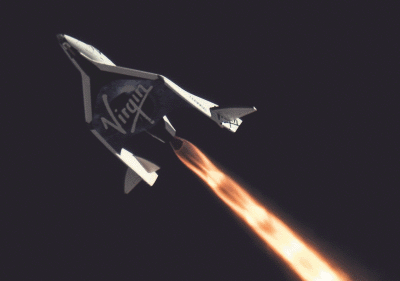Fri, Sep 06, 2013
Crew Flexes Spacecraft's Unique Feather System During Test
Virgin Galactic successfully completed the second rocket-powered, supersonic flight of its passenger carrying reusable space vehicle, SpaceShipTwo (SS2) on Thursday. In addition to achieving the highest altitude and greatest speed to date, the test flight demonstrated the vehicle’s full technical mission profile in a single flight for the first time, including a high altitude deployment of the unique wing “feathering” re-entry mechanism. All of the test objectives were successfully completed.

At approximately 8 a.m. local time from the Mojave Air and Space Port, the company’s WhiteKnightTwo (WK2) carrier aircraft took off carrying SS2 to an altitude of 46,000 feet. Virgin Galactic Chief Pilot Dave Mackay was at the WK2 controls, assisted by Scaled Composites (Scaled) co-pilot Mike Alsbury and The Spaceship Company Flight Test Engineer Scott Glaser. Upon release from WK2, SS2 pilots Mark Stucky and Clint Nichols, both of Scaled, ignited the rocket motor for the planned 20-second burn propelling the spaceship to 69,000 feet. During this time, SS2 achieved a maximum speed of Mach 1.43. SS2 landed in Mojave at 9:25 a.m. local time completing the flight test with the pilots reporting a flawless flight.
“This flight milestone represents a key step forward for the Virgin Galactic team," said H.E. Khadem Al Qubaisi, Chairman of aabar Investments PJS. "The successful completion of all major aspects of the flight mission demonstrates that we are very close to achieving one of Galactic’s key goals: commercializing access to space for the broader public. I would like to congratulate the whole team on their continued success.”
“We couldn’t be more delighted to have another major supersonic milestone under our belts as we move toward a 2014 start of commercial service,” said Virgin Galactic Founder Sir Richard Branson. “It was particularly thrilling to see for the first time today the whole elegant system in action during a single flight, including the remarkable feathering re-entry system. It was this safety feature more than anything else that originally persuaded us that the overall design of the system was uniquely fit for purpose. Everything we have seen today just confirms that view. Congratulations to all involved!”
“Today, we expanded the SpaceShipTwo rocket-powered flight test envelope with a longer burn duration and robust testing of the feather mechanism, supersonic aerodynamics and wing lift structure,” said Virgin Galactic CEO George Whitesides. “Each powered flight of SpaceShipTwo yields cumulative progress that builds the foundation for safe and exciting commercial space flights.”
(Image provided by Virgin Galactic)
More News
Circle To Runway (Runway Number) Used by ATC to inform the pilot that he/she must circle to land because the runway in use is other than the runway aligned with the instrument appr>[...]
Aero Linx: National Aviation Safety Foundation (NASF) The National Aviation Safety Foundation is a support group whose objective is to enhance aviation safety through educational p>[...]
At Altitude Of About 250-300 Ft Agl, The Airplane Experienced A Total Loss Of Engine Power On November 6, 2024, at 1600 central standard time, a De Havilland DHC-1, N420TD, was inv>[...]
From 2009 (YouTube Edition): Three Hour Flight Was 'Flawless' -- At Least, Until Mother Nature Intervened For anyone who loves the aviation business, this was a VERY good day. Afte>[...]
Also: AMA Names Tyler Dobbs, More Falcon 9 Ops, Firefly Launch Unsuccessful, Autonomous F-16s The Air Force has begun ground testing a future uncrewed jet design in a milestone tow>[...]
 ANN's Daily Aero-Term (05.05.25): Circle To Runway (Runway Number)
ANN's Daily Aero-Term (05.05.25): Circle To Runway (Runway Number) ANN's Daily Aero-Linx (05.05.25)
ANN's Daily Aero-Linx (05.05.25) NTSB Prelim: De Havilland DHC-1
NTSB Prelim: De Havilland DHC-1 Classic Aero-TV: The Boeing Dreamliner -- Historic First Flight Coverage
Classic Aero-TV: The Boeing Dreamliner -- Historic First Flight Coverage Airborne-NextGen 05.06.25: AF Uncrewed Fighters, Drones v Planes, Joby Crew Test
Airborne-NextGen 05.06.25: AF Uncrewed Fighters, Drones v Planes, Joby Crew Test



